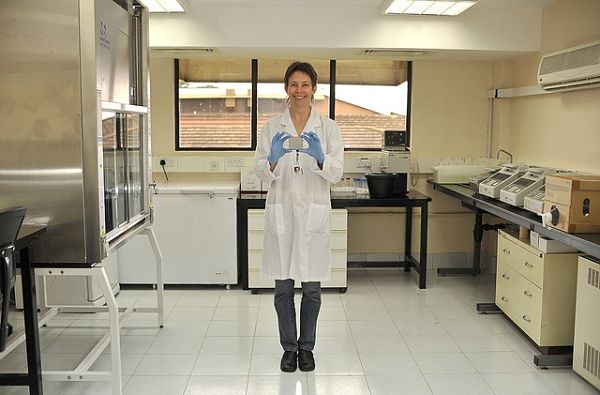It often happens that you do everything right with a PCR. You have perfectly isolated template DNA, used sterile tubes and tips, used clean reagents, and said a quick prayer to the PCR Gods. And still, something unknown messes up your results. This unknown at work is generally a PCR inhibitor. Before you blame it all on Murphy’s law and repeat an experiment, let’s understand why PCR inhibitors are such a nuisance and what we can do to prevent them.
What Are They?
PCR inhibitors prevent amplification of nucleic acids giving false results, decreased sensitivity, or complete failure of the PCR. Inhibitors bind to nucleic acids or polymerases and interfere with DNA replication or bind essential co-factors like Mg2+, reducing their availability by inhibiting enzyme-co-factor interaction. They may also prevent primers from annealing to DNA.
Where Do They Come From?
- Sample material: Tissue (e.g., collagen), blood (e.g. heparin, hemoglobin, immunoglobulins, proteases, nucleases), feces (e.g. bile salts, urea), cell culture medium, soil, plant material (e.g., chlorophyll)
- Sample preparation: Chemicals in extraction and preparation processes (e.g., KCl, NaCl, detergents like SDS, Tween-20, Triton-X-100, xylene); nucleases from you, the scientist
- Nucleic acid purification: Certain substances necessary for purification steps act as inhibitors if not removed or if present above a certain concentration (e.g. ethanol, isopropanol, phenol, sodium acetate). These escape removal during purification since they are co-purified with the nucleic acid. EDTA in TE buffer, which is regularly used to store DNA, inhibits PCR by sequestering Mg2+ ions.
- Dirty consumables: Powder from disposable gloves, nucleases on tubes and tips
Fun fact: Native immunoglobulin (IgG) present in blood is one of the most potent PCR inhibitors since it has exceptional affinity for single stranded DNA. This inhibitory effect is partially removed by incubating the sample with a nonspecific DNA to neutralize the IgG.
How Can You Identify PCR Inhibitors?
To find the problem, perform controls at every step of processing and purification to determine which step is leading to inhibitor contamination. Controls are your best bet in identifying which specific step is introducing inhibitors. Also, store a small portion of your sample at each step. This will help you go back to that step when necessary and re-analyze.
- Compare an internal positive control (same tubes) to an external positive control (different tubes) and observe amplification between the test and control reactions in parallel. These positive controls are the perfect controls as almost every variable in the PCR reaction, including the tube itself, is the same for the test and the control.
- Perform spectrophotometric analysis to determine presence of certain inhibitors. The A260/280 ratio should be close to 2 for pure RNA and 1.8 for pure DNA (a lower ratio means protein or phenol contamination). The A260/230 ratio should be close to 2.2 for pure RNA and 2 for pure DNA (a lower ratio means carbohydrate, guanidine, phenol or glycogen contamination).
- Perform HPLC or MS analysis to determine the exact cause of PCR inhibition in severe cases of unexplained chemical contaminations.
What Can I Do to Prevent PCR Inhibitors?
- Work under clean conditions with clean pipette tips and tubes to prevent contamination.
- Wear protective clothing like gloves, lab-coat and mask to avoid nuclease contamination from the experimenter.
- Use refined sample collection techniques. Change techniques if the source material does not give clean samples.
- Choose an appropriate purification method (e.g., Guanidium isothiocyanate extraction works better for certain samples, phenol–chloroform extraction works better for lipid contamination but be careful not to leave too much phenol because it too is an inhibitor).
- Use activated carbon, silica columns, cation exchange resins, magnetic silica beads, or immunocapture methods to remove inhibiting antigens. In forensics, where sample purity is always an issue, Chelex is commonly used to purify nucleic acids.
- Use commercial kits for DNA purification that enable extraction of inhibitors.
- Choose a mutant Taq polymerase that is more robust and inhibition-resistant.
- Store DNA in water instead of TE buffer. Make small aliquots and prevent multiple freeze-thaw cycles to overcome any degradation issues.
- Use additives or facilitators to impede inhibitors (e.g., Betaine, BSA, DMSO, formamide, glycerol, PEG, powdered milk, protease inhibitors, nuclease inhibitors). The choice of additive depends upon type of inhibitor.
- Dilute the PCR sample to dilute inhibitor. However, this may reduce sensitivity for difficult to detect targets.
Preventing Specific Inhibitors
- Phenol removal: use polyvinylpyrrolidone
- Polysaccharide removal: use Tween-20, DMSO, PEG or activated carbon
- Humic acids (common in soil and sewage samples) removal: dialysis, flocculation, column based methods, ultrafiltration
- Urea (common in urine samples) removal: dialysis, ultrafiltration
- Protease removal: protease inhibitors, BSA
- Ca2+ removal: add Mg2+, or other chelating agents
This is an overview with some general tips about PCR inhibitors. If you face inhibited PCRs, do a detailed analysis to identify the step in which inhibitors were introduced, the type of inhibitor, and its effect. Then, specifically research ways of dealing with that particular inhibitor. A thorough study will help quickly solve this problem and help you get a seamless PCR.
Need help making your PCR fail (a bit) less often? Download our free notorious PCR inhibitors poster and pin it up near your DNA engine. Or download the Bitesize Bio PCR eBook for more comprehensive practical guidance.
Further Reading
- Thermo Scientific technical bulletin T123 Rev 1/2012 https://tools.thermofisher.com/content/sfs/brochures/T123-NanoDrop-Lite-Interpretation-of-Nucleic-Acid-260-280-Ratios.pdf accessed 2017-05-28.
- Schrader C et al. (2012) PCR inhibitors – occurrence, properties, and removal. J Appl Microbiol 113(5):1014-26.
- Abu Al-Soud W et al. (2000) Effects of amplification facilitators on diagnostic PCR in the presence of blood, feces, and meat. J Clin Microbiol 38(12):4463-70.
- van Pelt-Verkuil et al, Principles and technical aspects of PCR amplification. Springer 2008, ISBN 978-1-4020-6240-7






